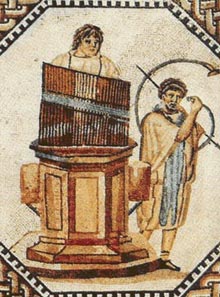Hydraulis of Dion

The Hydraulis of Dion (
Excavation history

At the beginning of the 1980s, the area was drained east of the main road of ancient
The instrument
The Pipe organ is considered the oldest keyboard instrument in the world. It was built in the 3rd century BC, invented by the engineer Ctesibius in Alexandria.
The height of the instrument is 120 cm, width 70 cm. The organ pipes are arranged in two stops and consist of 24 pipes with a diameter of 18 mm and 16 narrow pipes with about 10 mm diameter. They were decorated with silver rings. The body of the organ was decorated with silver stripes and multicolored, rectangular glass ornaments. Valves were opened by keyboard and the air flowing through the organ pipe generated the sound. The instrument is structurally classified between the water organ described by Hero of Alexandria and Vitruvius.[3]
Spreading as a musical instrument
After its invention in the Egyptian Alexandria, the organ arrived in Greece in the

Replica of the hydraulis of Dion
With the support of the Greek Ministry of Culture and Sport and the help of Professor Pandermalis, a reconstruction of a water organ was started at the European Cultural Center of Delphi in 1995. They kept to ancient records and to the original excavated in Dion. The instrument was completed in 1999.[5]
Literature
- Dimitrios Pandermalis: Η Ύδραυλις του Δίου. In: Ministry for culture, Ministry for Macedonia and Thrace, Aristotle-University Thessaloniki: Το Αρχαιολογικό Έργο στη Μακεδονία και Θράκη. Archived 21 September 2022 at the ISSN 1106-5311pages. 217–222. (Greek language)
- Dimitrios Pandermalis: Dion. The archaeological site and the museum. Athens 1997.
- Hellenic Republic, Ministry of culture and sports, Onassis Foundation USA: Gods and Mortals at Olympus. S. 26, Edited by Dimitrios Pandermalis, ISBN 978-0-9906142-2-7.
- Free Travel Guide about the Olympus region Title: Mount Olympus - Ancient Sites, Museums, Monasteries and Churches
References
- ^ Vitruv, DE L'ARCHITECTURE. LIVRE X, VIII. Des orgues hydrauliques. (in Latin and French language)
- ^ Pandermalis: Η Ύδραυλις του Δίου. 1995, page 217.
- ^ Pandermalis: Η Ύδραυλις του Δίου. 1995, page 218.
- ^ The ancient hydraulis. Retrieved 9 February 2018.
- ^ "Ancient Hydraulis: The reconstruction". Archived from the original on 2 August 2021. Retrieved 9 February 2018.
